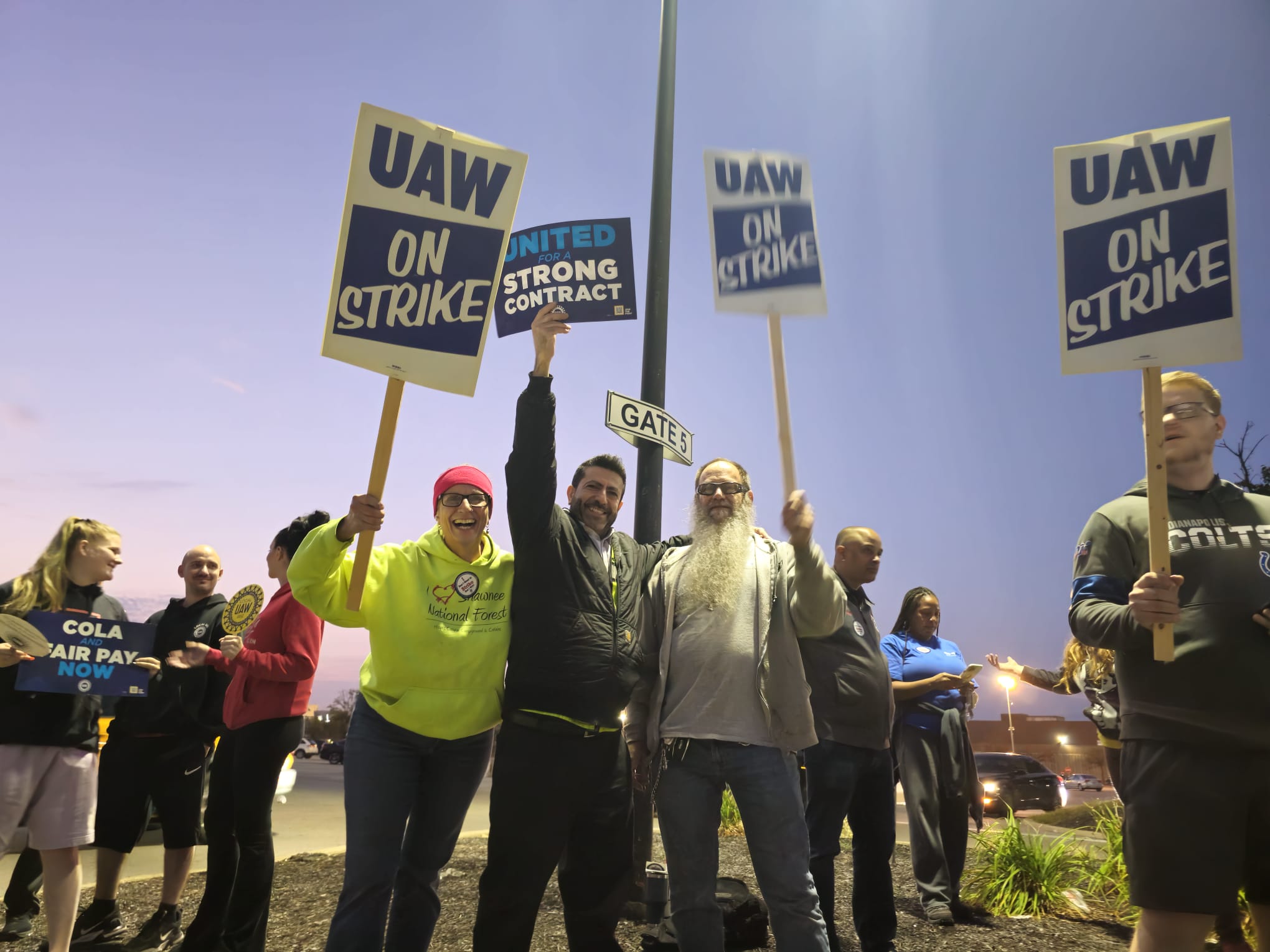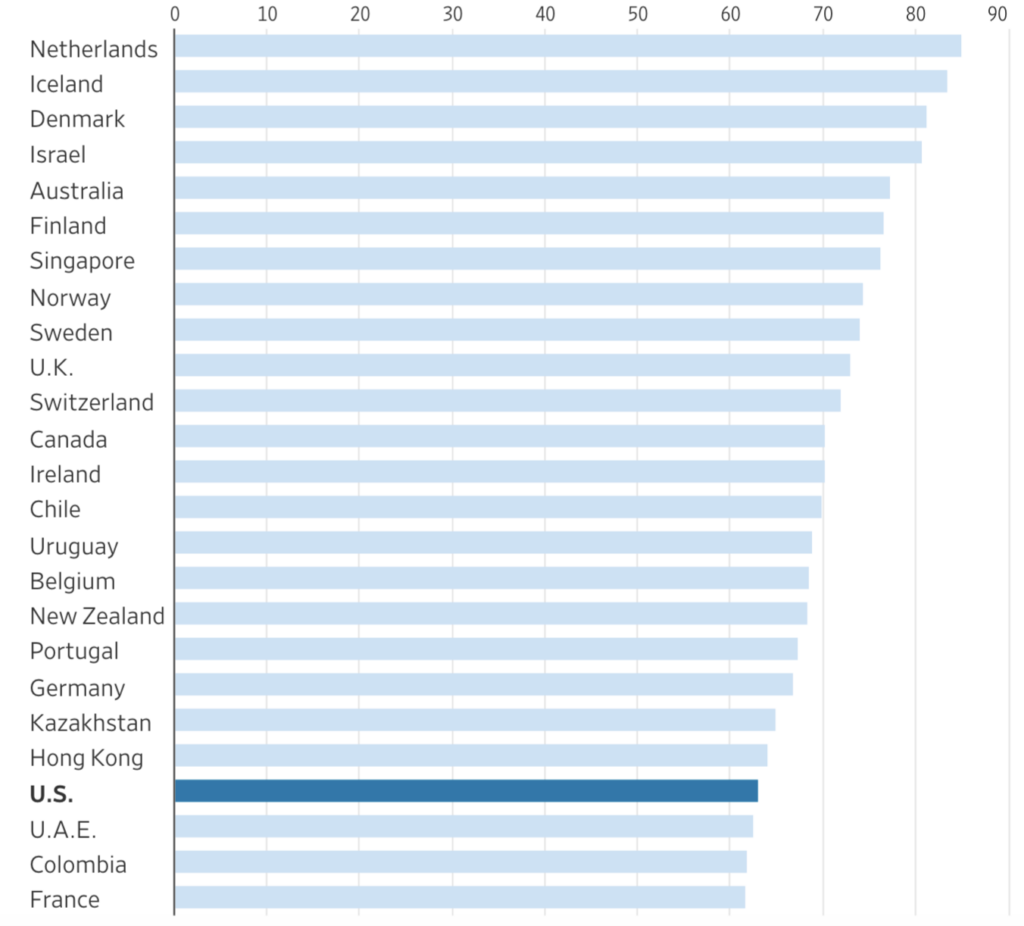Menu
Just Transition Insights, Issue #23, 10/30/2023
By Jonathan Tasini
|

[Editorial Note: To bring our readers the most in-depth analysis and comprehensive information from around the globe curated by our small staff, we’ve decided, for the time being, to publish our newsletter monthly. Please send us ideas and feedback!]
Leading Off: An EV Battery Plant Might Show The Way
We’ve taken the position many times that the only path to a secure “high bar” Just Transition is via collective bargaining. To be sure, political leaders are promising to deploy funds for retraining, early retirement and economic development—but a promise made by a politician or party in power today can be reversed or ignored by the results of an election. It should be, thus, a concern that this is an era of waning union density, in many parts of the world, and a reliance on a global supply chain model that is based principally on employing low wage—in other words, non union—workers.
That’s why there is an element out of the recent news of the strike by the U.S. United Auto Workers against the Big Three auto makers that is, perhaps, revolutionary (as of this writing, there have been tentative agreements reached with all of the auto makers but those agreements must still be ratified by a vote of members):
General Motors Co. CEO Mary Barra confirmed Tuesday that the automaker has made an offer to the United Auto Workers that would put the Ultium Cells LLC joint-venture battery plants “under the scope of the master agreement” the automaker has with the union.
Barra made the acknowledgement during the third-quarter earnings call with investors, a few weeks after the UAW announced that GM had agreed to include its battery plant workers under the master agreement with GM.
GM has only one operating Ultium plant with partner LG Energy Solution. Workers at that northeast Ohio plant voted to organize with the UAW in December 2022. While they’ve received wage increases, they are still waiting for an inaugural contract.
A big cautionary red flag: we won’t know if the above becomes reality until the details of the entire UAW tentative contract with GM see the light of day.
We can view this as an important step in setting a framework for a “high bar” Just Transition. As we noted back in January, Ultium workers voted overwhelmingly—710 to 16—to join the UAW. That translated into an immediate wages of $3 to $4 an hour, and back pay for hundreds of workers in the thousands of dollars.
But, pulling Ultium into the master contract is a much bigger step for two reasons. First, by viewing Ultium workers as an indistinguishable part of the General Motors workforce, it will raise the Ultium pay and benefit standards even higher and prevent the whipsawing down of wages for the rest of the GM workforce.
Second, it sets a standard for the entire auto industry globally, especially for the other auto companies who are racing ahead to build out battery plant joint ventures with non-union companies.
SPONSOR MESSAGE
A message from the Australian Mining And Energy Union
We are fighting back, not just for ourselves but for the future generation of mineworkers. Workers deserve better. Our families and communities deserve better. Visit us

Spotlight: The California EV Vision—Revisited
Recently, we examined the Zero-Emission Vehicle (ZEV) Market Development Strategy for California which is an anchor document for the plans for other state agencies grappling with the plan to convert to EVs.
To remind our readers, the document singles out workforce as one of the four pillars of the strategy:
Workforce: The human workforce, including supply chains, needed to design, manufacture, sell, construct and install, service and maintain ZEVs, ZEV infrastructure, ZEV distribution systems, dealerships, energy systems, networks of charging and fueling stations, and other ZEV-related build. Workforce also includes those at third-party support companies and agencies whose work with ZEV focused institutions is critical to operating and expanding the ZEV market, such as marketing and advertising firms, roadside assistance companies, financial institutions, insurance agencies, and recyclers.
The document also addresses “Complimentary” initiatives:
Economics and Workforce— Just transition. Per EO N-79-20, the Labor and Workforce Development Agency and Office of Planning and Research are working with a group of state agencies to design a Just Transition Roadmap, which is an economy-wide strategy to ensure that all Californians benefit from the transition to carbon neutrality, including communities and workers most impacted by climate change and the realignment of fossil fuel industries. The ZEV Strategy will leverage this work, and other related efforts, to ensure California is prepared to meet the needs of the ZEV market.
So, we had a chance to have a virtual discussion with Tyson Eckerle, Senior Advisor for Clean Infrastructure and Mobility for the state’s Office of Business and Economic Development (GO-Biz), to get some insight into the workforce plan. A caveat: as Tyson acknowledged, workforce is not his specific area of responsibility.
He acknowledged that part of the issue in the auto industry in California is “the auto industry is new relative to Michigan..and of course our big auto industry people are Tesla, [and] Tesla‘s not unionized”. He used the example of the Alliance for Renewable Clean Hydrogen Energy Systems (Arches), which describes itself as “a public-private partnership to create a sustainable statewide clean hydrogen (H2) hub in California and beyond, utilizing local renewable resources to produce hydrogen with the objective to fully decarbonize the regional economy, while prioritizing environmental justice, equity, economic leadership and workforce development.”
The state building and construction trades, and most, if not all, organized labor is behind ARCHES,” he says. “There’s a lot of excitement from organized labor.” 220,000 jobs. “All of the projects will have PLAs [project labor agreements]…We’re really excited to partner with organized labor. There’s a lot of promise…We still have a lot of refinery workers…so we can start to transition that workforce a bit…With each of them we have opportunities to require PLAs.”
We emphasized another aspect, pointing out that the PLAs, while a good step, typically only cover the construction element of any project—but not the workers involved in the on-going operations and work long-term. Eckerle said PLAs would cover operations—but we pointed out, and he acknowledged, that the vast majority of the companies that appear to be partners in the overall Go-Biz efforts are non-union. “I don’t think we have to go that far,” he said—meaning, requiring companies must become unionized.
“There’s a lot of shifts at foot…that we have to be mindful of,” he told us. He agreed that many companies will seek lower labor costs, and set up shop in the non-union Southern states of the U.S. He appeared to agree with our view that there is “no road to high-bar jobs without unions” and, specifically, that high wages are needed for an economy anchored on consumer spending. “Job #1 is to create a good job for people, people are worried about putting food on the table…” he said as we summed up.
We will continue the dialogue and offer input into the evolving state strategy. We invite our readers to read the documents we’ve linked to and offer suggestions.
Ideas: Why Pensions Matter For Just Transition
One approach to ensuring a “high bar” Just Transition is to build out a plan to allow workers to retire early with a pension equal—or higher—than she or he could count on if she or had worked for an entire career. This graph of an index of global pension security shows the problem (courtesy of The Wall Street Journal):

A significant number of countries defined as “advanced economies” rank at the bottom of pension security, including the United States; this graph measures whether pensions are adequate, sustainable and secure.
Thus, to ensure a “high bar” Just Transition for older workers who lose a job and who might find it harder to obtain a new job with adequate wages, pension systems have to be strengthened—principally, that means increasing benefits.

Opinion: The Un-Serious Upcoming COP Summit
In less than one month, climate change “summit tourism” will go into overdrive. That’s when thousands of people will descend on Dubai for the 28th gathering of COP, or as its official name, the United Nations Climate Change Conference or Conference of the Parties of the UNFCCC.
I referred to these gatherings last year as “summit tourism”, while virtually nothing was concretely committed to for workers’ Just Transition, I assumed the thousands of people who participated in COP 27 enjoyed the beautiful beaches of Sharm el-Sheikh. Whether the money and time expended—not to mention the collective carbon spewed into the atmosphere by the people traveling across the globe for the summit—translated into anything worthwhile is highly debatable.
Last year’s summit, COP27, made it abundantly clear that workers just don’t explicitly figure into the calculations of the parties gathering in the negotiating rooms who bicker over the details of climate change.
More explicitly, as COP28 looms, unions must confront a fundamental question: why should precious and finite resources (time and money) be spent trying to play within a framework that is entirely oblivious of workers?
The game is fixed against workers’, and unions, in such a fundamental way that the U.N., and the related international forums on climate change, are simply not the places workers will ever secure a “high bar” Just Transition.
That was quite obvious in key language used by COP27 in its final documents.
The final COP27 document—the so-called “implementation” document—did not use the word “workers” or “unions” even once.
So, as people prepare to travel to Dubai, we ask again whether the COP gathering will be anything but a performative event.
Unless they prove otherwise, it will remain an unserious place for the discussion of workers’ futures.
Tasini is the founder and executive director of Just Transition For All
Links
UAW: The United Auto Workers website for up-to-date information on the current strike.
Table of Contents
Leading Off
An EV Battery Plant Might Show The Way
Spotlight
The California EV Vision—Revisited
Ideas
Why Pensions Matter For Just Transition
Opinion
The Un-Serious Upcoming COP Summit
Links
This Week's Links
Can’t wait to subscribe to the newsletter?
*We post information pursuant to the U.S. Fair Use Doctrine, and applicable international standards, in order to advance the knowledge base and education of our global audience. We endeavor to include the original link to documents. However, upon requests of original authors of posted documents, where explicit use permission is not granted, we will remove documents if it is determined continued use is not appropriate. We also reserve the full right to not include, or remove, any data inconsistent with our mission.















